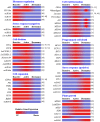Exploring the Seasonal Dynamics and Molecular Mechanism of Wood Formation in Gymnosperm Trees
- PMID: 37239969
- PMCID: PMC10218545
- DOI: 10.3390/ijms24108624
Exploring the Seasonal Dynamics and Molecular Mechanism of Wood Formation in Gymnosperm Trees
Abstract
Forests, comprising 31% of the Earth's surface, play pivotal roles in regulating the carbon, water, and energy cycles. Despite being far less diverse than angiosperms, gymnosperms account for over 50% of the global woody biomass production. To sustain growth and development, gymnosperms have evolved the capacity to sense and respond to cyclical environmental signals, such as changes in photoperiod and seasonal temperature, which initiate growth (spring and summer) and dormancy (fall and winter). Cambium, the lateral meristem responsible for wood formation, is reactivated through a complex interplay among hormonal, genetic, and epigenetic factors. Temperature signals perceived in early spring induce the synthesis of several phytohormones, including auxins, cytokinins, and gibberellins, which in turn reactivate cambium cells. Additionally, microRNA-mediated genetic and epigenetic pathways modulate cambial function. As a result, the cambium becomes active during the summer, resulting in active secondary xylem (i.e., wood) production, and starts to become inactive in autumn. This review summarizes and discusses recent findings regarding the climatic, hormonal, genetic, and epigenetic regulation of wood formation in gymnosperm trees (i.e., conifers) in response to seasonal changes.
Keywords: conifer; environment; epigenetic; genetic; gymnosperm; season; wood formation.
Conflict of interest statement
The authors declare no conflict of interest.
Figures


Similar articles
-
Regulation of cambial activity in relation to environmental conditions: understanding the role of temperature in wood formation of trees.Physiol Plant. 2013 Jan;147(1):46-54. doi: 10.1111/j.1399-3054.2012.01663.x. Epub 2012 Jul 11. Physiol Plant. 2013. PMID: 22680337 Review.
-
Cold stability of microtubules in wood-forming tissues of conifers during seasons of active and dormant cambium.Planta. 2012 Jan;235(1):165-79. doi: 10.1007/s00425-011-1500-2. Epub 2011 Aug 23. Planta. 2012. PMID: 21861112
-
Localized cooling of stems induces latewood formation and cambial dormancy during seasons of active cambium in conifers.Ann Bot. 2016 Mar;117(3):465-77. doi: 10.1093/aob/mcv181. Epub 2015 Dec 24. Ann Bot. 2016. PMID: 26703452 Free PMC article.
-
Photoperiod and temperature as dominant environmental drivers triggering secondary growth resumption in Northern Hemisphere conifers.Proc Natl Acad Sci U S A. 2020 Aug 25;117(34):20645-20652. doi: 10.1073/pnas.2007058117. Epub 2020 Aug 5. Proc Natl Acad Sci U S A. 2020. PMID: 32759218 Free PMC article.
-
Molecular control of wood formation in trees.J Exp Bot. 2015 Jul;66(14):4119-31. doi: 10.1093/jxb/erv081. Epub 2015 Mar 5. J Exp Bot. 2015. PMID: 25750422 Review.
Cited by
-
Seasonal Developing Xylem Transcriptome Analysis of Pinus densiflora Unveils Novel Insights for Compression Wood Formation.Genes (Basel). 2023 Aug 26;14(9):1698. doi: 10.3390/genes14091698. Genes (Basel). 2023. PMID: 37761838 Free PMC article.
-
The Development of Plant Genome Sequencing Technology and Its Conservation and Application in Endangered Gymnosperms.Plants (Basel). 2023 Nov 28;12(23):4006. doi: 10.3390/plants12234006. Plants (Basel). 2023. PMID: 38068641 Free PMC article. Review.
-
Annual Dynamic Changes in Lignin Synthesis Metabolites in Catalpa bungei 'Jinsi'.Metabolites. 2025 Jul 22;15(8):493. doi: 10.3390/metabo15080493. Metabolites. 2025. PMID: 40863112 Free PMC article.
-
Phytohormones involved in vascular cambium activity in woods: current progress and future challenges.Front Plant Sci. 2024 Dec 17;15:1508242. doi: 10.3389/fpls.2024.1508242. eCollection 2024. Front Plant Sci. 2024. PMID: 39741679 Free PMC article. Review.
References
-
- FAO . Global Forest Resources Assessment 2020—Key Findings. FAO; Rome, Italy: 2020. p. 16.
-
- Richardson A.D., Keenan T.F., Migliavacca M., Ryu Y., Sonnentag O., Toomey M. Climate change, phenology, and phenological control of vegetation feedbacks to the climate system. Agric. For. Meteorol. 2013;169:156–173. doi: 10.1016/j.agrformet.2012.09.012. - DOI
-
- Cooper R.J. World markets for coniferous forest products: Recent trends and future prospects. Acta Hortic. 2003;615:349–353. doi: 10.17660/ActaHortic.2003.615.37. - DOI
Publication types
MeSH terms
Grants and funding
LinkOut - more resources
Full Text Sources
Research Materials

